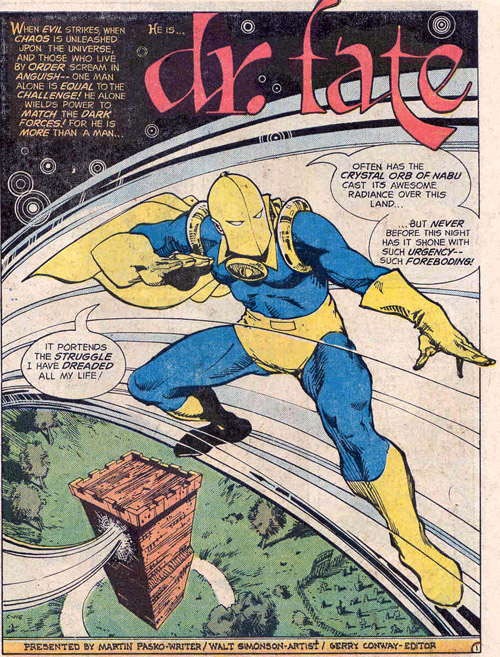Who's This? A magical helmet with a body under it.
The facts: Created by Gardner Fox and Howard Sherman, Dr. Fate first appeared in More Fun Comics #55 (May 1940) and was even the book's cover feature at times, his Golden Age career taking him to issue #98 (though by that time, he was wearing a half-helmet and was more Superman than Zatara) and earning him a founding spot in the Justice Society of America. After the obligatory appearances in the Silver Age's JLA/JSA team-ups, DC tried to make a go of him in Showcase #55-56, then in 1975's 1st Issue Special #9, to no avail. 1980 saw the publication of an origin story in DC Special Series #10 and a series of back-ups in The Flash (of all places) in 1982. He made a bigger mark as one of the main members of Roy Thomas' All-Star Squadron. In 1987, Kent Nelson was finally retired and replaced with a new paradigm, courtesy of Eric and Linda Strauss who would premiere in a mini-series then go to series by J.M. DeMatteis. From there, Inza Nelson took the helmet, until the Nelsons were replaced by the very 90s "Fate". The Helmet of Nabu returned, of course, and different people have incarnated the superheroic magic-user since. Khalid Nassour is the current Dr. Fate, appearing in JSA comics (a rebooted Khalid Ben-Hassin from the New52).How you could have heard of him: DC's "sorcerer supreme", Dr. Fate is well known to comics fans, but for the mainstream, his recent appearance in the Black Adam movie (played by Pierce Brosnan) would be the most noteworthy, or perhaps his live action incarnation in Stargirl. To be fair, Fate had also been in Smallville, and a lot of DC animated series and films.
Example story: 1st Issue Special #9 (December 1975) "The Immortal Destiny" by Martin Pasko and Walt Simonson
Presumably set on Earth-2 in 1955, a "first issue special" meant to be a try-out for an ongoing series should probably have found a way to introduce Fate to the modern-day Earth-1. But aside from car models seen in the story, it might as well have been. We're under the spell of Walt Simonson's beautiful art anyway. And an old evil stirs...
I'm a big fan of Dr. Fate whose look enchanted me as a kid - thanks to his Super-Powers action figure initially - but I also love the trappings, like the Tower of Fate in Salem. One of the great superhero HQs, surely. And though Pasko and Simonson could have done ANY mystical-type story, they tie it back to Dr. Fate's origins in Antiquity and set him up against a mummy!
I think it would be true to say that one of the appeals of both Doctors Strange and Fate is the special effects, at least in their best-told stories. But Fate isn't unbeatable, and this particular skirmish ends with Khalis stealing his Amulet of Anubis. And so he flies back to his wife Inza, exhausted.
Inza throws a mean coffee cup. Being Dr. Fate is a little like being the Hulk. You're not in control. Clearly sick of all this, Inza leaves, slamming a portal behind her. And the half of Dr. Fate that is Kent Nelson does hear her words (what a time to feign sleep), while the other half thinks of only one thing - Kahlis. So he gets up and he studies his old books and tablets. And he finds the evil high priest who lived back in 2030 B.C., a MAD priest of Anubis who destroyed other gods' temples. And Nabu took the Amulet of Anubis from him - information Nabu failed to tell Fate (this is before Nabu is specifically Dr. Fate's guiding mind) - and so a feud was sparked, and Anubis would make sure Khalis "survived" to get his Amulet back once more. Armed with this understanding, Dr. Fate leaps into action and battles Khalis before the mummy can summon his dreadful god.
Important to note here that Dr. Fate is also a PHYSICAL character. He has been played as a very cerebral, distant caster of spells, but in the Golden Age (leading to the half-mask, nerfed years), a certain amount of superhero fisticuffs was expected. So we have a bit of that before Fate unleashes the full power of Industrial Light and Magic. But Khalis once again gets away, and it may fall to Inza to find him. Yeah, she regrets having left Kent in dire straights, so she's investigating Khalis on her end. Just as Fate gets his bearings, she drives up with something she found at the museum where the mummy had been exposed - Khalis' secret magical name on a stone fragment! While they've been chatting, Khalis has been completing rituals, and Boston got a makeover. And Anubis is summoned, except... he doesn't remember Khalis. Like, at all. Big "Notice me, Sempai" energy coming from the mummy.Anubis mocks him, but look, if he manages to destroy that annoying Dr. Fate, he'll consider bringing his mad priest back into the fold. Battle is enjoined for a third time, but Fate uses Khalis' magical name and destroys him with the power of the sun god, Amon-Ra:Only just enough space for Inza to drive the spent Kent Nelson home, the couple reunited. So...
How does something of this quality - strong premise, incredible visuals, and open-ended introduction - NOT go to series? Especially in the occult-obsessed 1970s? It's a mystery. But given so few 1st Issue Specials actually begat series (Warlord and New Gods are the only ones), it's not clear how much of a commitment the series actually entailed. Though the Helmet of Nabu has made the rounds, Dr. Fate continues to be a striking character that was probably never so pure in concept as he was here.
Who's Next? A kid-hating villain.










Comments